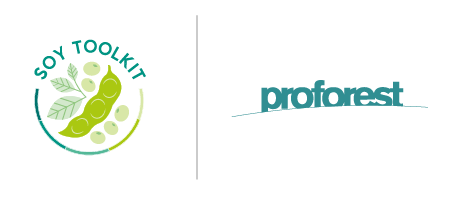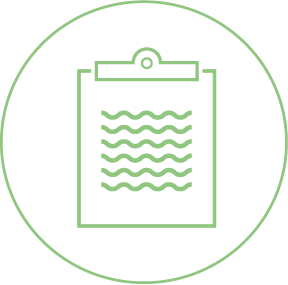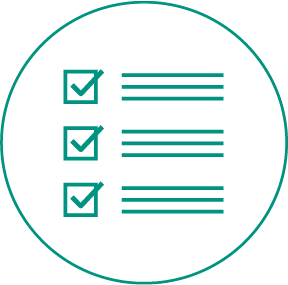Element 2: Understand supply chain risks
Implementation of responsible sourcing commitments happens on the ground by soybean producers. Companies need to know where their soy is coming from to assess compliance with their policies and to ensure that, whenever a supplier fails to meet the policy criteria, an appropriate plan for full compliance is in place. Risk analysis is a useful approach to support the prioritisation of resources, identify appropriate actions and plan for interventions, especially for downstream companies.
This element aims to depict how soy buying companies can:
Define a traceability process to map their supply chain
Define a risk analysis process, to understand risks of non-compliance with the policy and plan for further engagement
Prioritise suppliers for engagement
TRACEABILITY
1. Define what “traceable” means
This will differ according to a company’s position in the supply chain.
Upstream companies can prioritise traceability where there is higher risk of non-compliance. They can aim to reach production level first for direct soybean purchases and then for indirect purchases (for example, when buying from a silo or a cooperative).
Downstream companies can start on products with a greater soy footprint and a shorter supply chain. They can aim for incremental granularity, which may begin with country level and progress to biome, state, municipality and then crusher level.
2. Gather information from your direct suppliers
Collaboration is key to the success of a traceability programme. Companies should engage with direct suppliers to explain why traceability is needed and what information they are expected to share.
3. Map your supply chain
After gathering information from direct suppliers, companies can then map their supply chain. A set of approaches and tools can be used, such as open platforms, supplier programmes, own traceability systems or contract a ready-to-use system.
4. Categorise volumes purchased and validate the information
Define as ‘known’ the volumes of soy that can be traced back to the production / municipality / regional level and as ‘unknown’ soy that cannot be traced back. Companies may want to validate information provided by suppliers using a due diligence process.
5. Monitor traceable volumes
The soy market is dynamic, which means frequent changes in the supply base and volumes sourced. To deal with that, companies can set up a system to update and review the volumes reported as ‘known’ at regular intervals, according to the prevailing purchase model.
Key points
Traceability of soy is important to enable companies to assess whether their procurement policies on deforestation and other environmental and social issues are being met at the production level.
This is a long-term process as part of supplier engagement, and it may take years to achieve full traceability to production level.
The further downstream a company is, the more it needs to rely on upstream suppliers’ actions to achieve traceability.
Soy traceability is not an end in itself: improving supply chain transparency on how and where soy is produced is only a tool to enable companies to take positive action towards compliance with their commitments.
Learn more in Briefing note 2A: Soy traceability and supply chain transparency.
Risk analysis
Resources being limited, prioritisation is key. This may particularly be the case for downstream companies with large and complex supply bases. Risk analysis can be performed at different stages of the policy implementation, which means that its results can inform different types of decisions, such as developing procurement policies or helping to identify areas for which more detailed analysis is needed.
1. Translate policy requirements into risk factors
It is possible to link potential negative impacts of soybean production (which breach companies’ policies) to risk factors that affect the likelihood of these impacts happening.
2. Assess suppliers’ performance
Many upstream and downstream soy buying companies have formulated policies which address negative social and environmental impacts happening in their supply chains. The following criteria are examples of risk factors that can be verified to assess a supplier’s likelihood of being non-compliant:
If the supplier has stringent commitments and policies in place that are aligned with the buying company;
Whether there is evidence of policy implementation and if the supplier reports on progress in a transparent way;
Whether the supplier is a member of a certification scheme, such as the Round Table on Responsible Soy (RTRS) or ProTerra, and if they are certified;
If the supplier has a robust traceability and/or purchase control system in place.
3. Assess geographical risk
In geographical risk assessments, two types of information are combined:
Information on the location of production;
Environmental and/or social risk information that has a geographical component.
4. Perform spatial risk analysis
GIS can be used to analyse risks in each sourcing geography. Risk of deforestation, for instance, can analysed by overlaying farm boundaries, crusher or silo locations with the deforestation maps. The Agroideal online risk assessment platform produces reports with risk classification of areas combining several layers of information.
5. Prioritisation and next steps
Risk assessment results enable companies to decide on different actions and timings for engaging with suppliers. For a downstream company, for example, the results of a high-level risk assessment may help to prioritise regions for ramping up supply chain mapping efforts, or may inform the criteria for the purchase control system in an upstream company.
Risk analysis key points
The purpose of a risk analysis is not to simply avoid risk. On the contrary, high risk areas may have the biggest potential for a positive change.
By identifying risks of noncompliance with commitments or negative impacts of production, companies can prioritise soy suppliers and/or sourcing areas for engagement.
Supplier risk profiles can be developed in-house and/or by using existing company performance scorecards.
Geographical risk information is widely available for land use change and deforestation. It can be gathered from a variety of providers. Geographical information on social issues is much scarcer.
While prioritising high-risk suppliers for engagement may bring greater positive impact, low-risk suppliers should not be overlooked.
Learn more in Briefing note 2B: Soy risk analysis.










